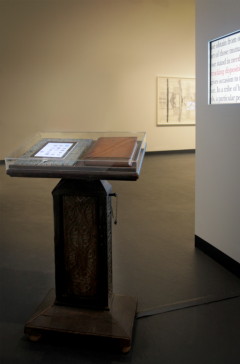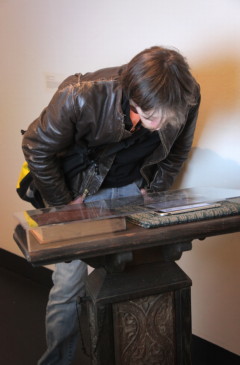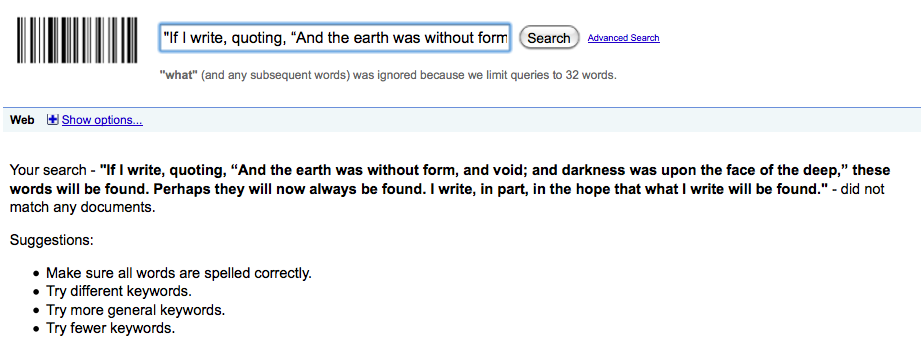Read for Us
Mixed media installation, custom software, 2010
Installed for the Faculty Triennial Exhibition, David Winton Bell Gallery, Brown University
December 4, 2010 - February 12, 2011
A software entity reads through Adam Smith’s An Inquiry into the Nature and Causes of the Wealth of Nations (1776), highlighting phrases, up to six words in length, that might have been written by any of us. We know that we might have composed these successive short sequences of words because a search engine has found them on web pages unconnected with Smith and his book. The software reader then sends our phrases to another client entity, a puppet not unlike ourselves, who re-searches and re-reads these phrases on Google and other portals, seeking to discover another nature and other causes of the wealth of nations now.
Underlying Processes

Photos: Danny Cannizzaro
The basic workings of Read for us are relatively straightforward. A typographic display moves through the public domain edition of The Wealth of Nations from Project Gutenberg phrase by phrase, and then sends these phrases to a search engine, allowing the search engine to provide us with its own reading of Adam Smith's famous text. The physical book is closed to us, while one of its digital editions is open in a new if now familiar way, within a culture of inquiry that is pervasive although still little-examined in terms of its effects on reading, particularly reading that is sustained over time, as this one is.
And there are subtleties to the subprocesses at work that may be of interest to some readers.
the Perceptual Reader

In itself, the software reader—on the larger screen and to which we currently refer as a Perceptual Reader—is of some interest. This name derives from the area of our visual perception that moves over a written or typeset text on an inscribed surface as we read. Studies show that we only actually see about 30-40 characters distance around the central point of our attention.[1] The Perceptual Reader presents the line of the text being read in constant movement at the center of the screen, like a familiar LED display, however, crucially, it also gives the reader a typographic neighborhood, something that we believe is a vital dimension of our current traditions of reading. We show the line of the text in movement,[2] but we also show an approximation of the words that would have surrounded our point of attention as we read these words on a printed page, or on a website's layout, for that matter. Typographic neighborhood is crucial to the Readers Project.
what the Perceptual Reader reads
writing to be found
In this installation of Read for us a Perceptual Reader simply moves steadily through the entire text of the first volume of Adam Smith's Wealth of Nations. It reads up to six words at a time but it chooses which words to read more carefully than may be apparent. At any one time, it only reads sequences of words that can be found in the indexes of Google Books where they are not associated with this work by Adam Smith.[3] The reader first checks that other writers have also used each sequence of words that it has selected from Smith's text in order to compose their own books and articles. As short sequences, these words are not unique to Smith. They have also be been composed by others and, in a sense, without reference to Smith, they could have been written by anyone, including ourselves.

This approach to reading and writing is part of another interrelated project initiated by John Cayley, with the working title, writing to be found.
reading with Google
Clearly, Read for us demonstrates—critically, and with a certain irony—contemporary modes of reading, contrasting them with those of the past or of 'deep' as opposed to 'hyper' attention.[4] Google reads, for us, the founding text of political economics. Google's free market of search phrases—of popular, commercial, and pretended cultural vectors—takes the place of the text itself. Was this development implicit in Smith's Inquiry?
Ted Widmer, Susan Danforth and the John Carter Brown Library for loan of their early quarto copy of
The Wealth of Nations, vol. 1.
Harriette Hemmasi, Barbara Schultz, Edwin Quist, Robert Emlen, Ann Dodge (all of Brown University Library); Samantha Gorman, Danny Cannizzaro, Lee Kuczewski of Providence Optical for help in trying to track down a good lectern.
Final thanks to the Annmary Brown Memorial for loan of the lectern.
Ian Hatcher for help with Ajax, and Ben Lichtner for insights into the 'Perceptual Reader.'
Ozzy Sewell of the Brown CIS Help Desk for networking configuration.
Maya Allison, for her curatorial and organizational help.
Ian Budish, Cameron Shaw and everyone at the David Winton Bell Gallery.